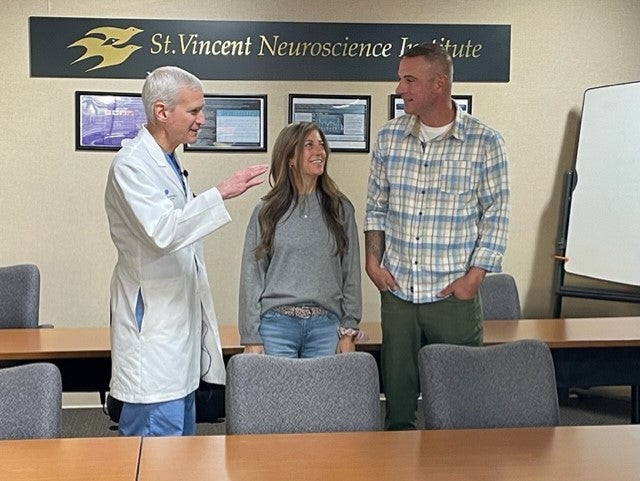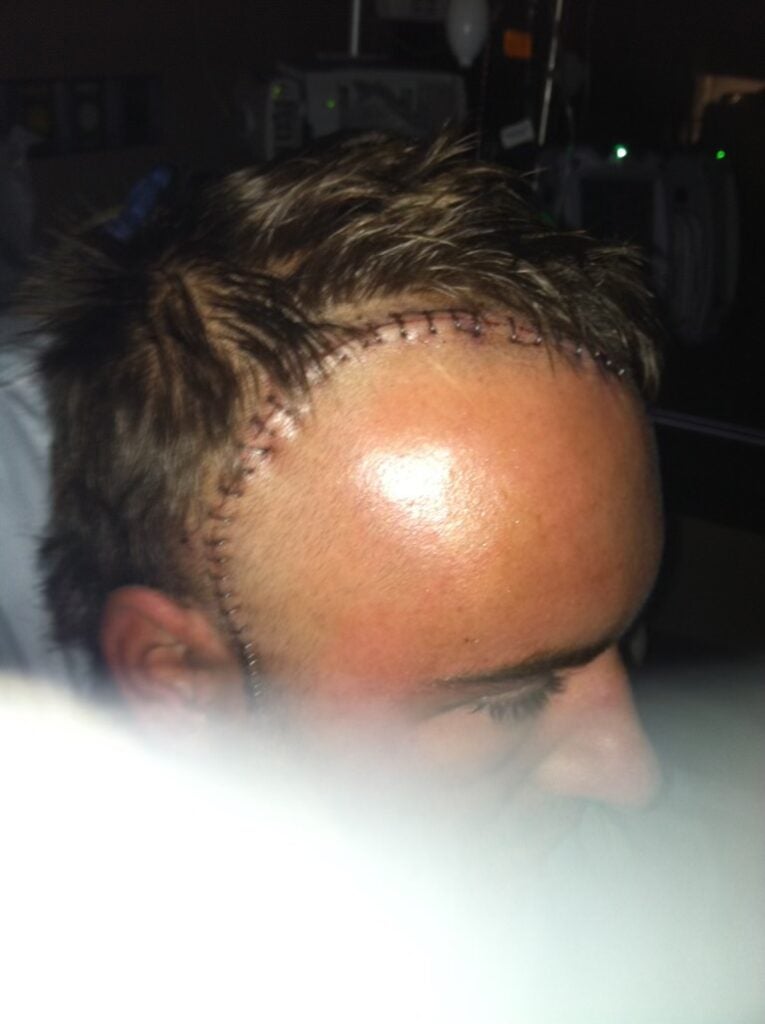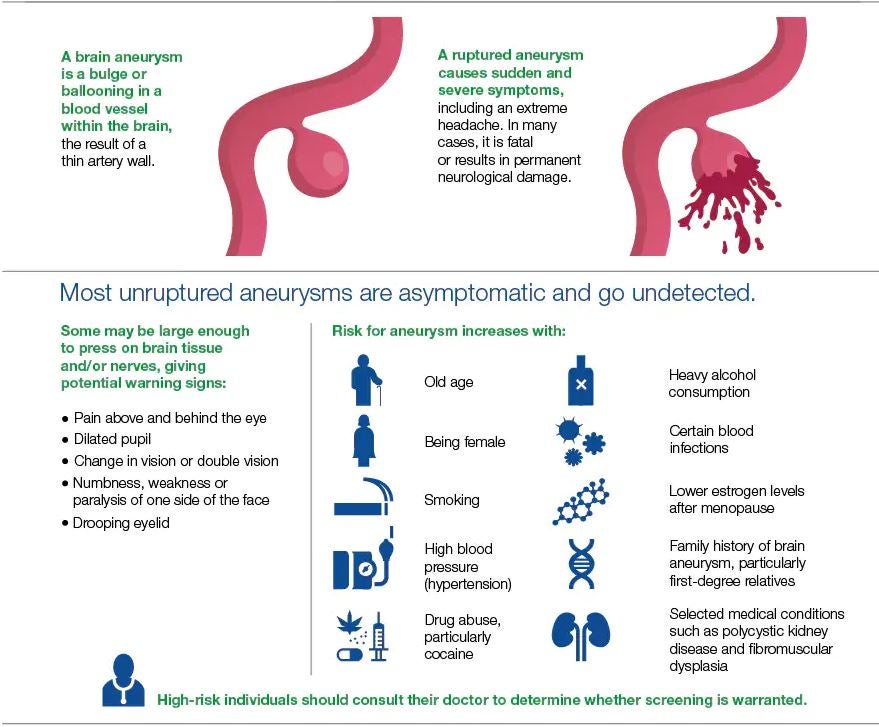Hancock County couple shares ‘one of a kind’ brain bleed story
INDIANAPOLIS (WISH) — A Hancock County couple is sharing their ‘one of a kind’ medical story. Both had brain bleeds and brain surgery, and both are lucky to be alive.
Nick and Carrie Kleiman look like the picture of health. He is a firefighter and she is a flower farmer. They’re in their 40s, now able to walk into a hospital themselves and laugh.
“We have good – bad luck Nick likes to say,” Carrie said with a laugh. “We have bad luck, but it ends up good.”

It all started nine years ago when Nick suddenly passed out, and then woke up to the worst headache of his life.
“It was the worst headache I have ever had and it was sudden, very sharp. It felt like someone hit me in the head with something really hard like a hammer,” Nick said.
He’s a paramedic and firefighter, so he knew something was wrong. They rushed him to the emergency room and he got a CT scan.
“It was a subarachnoid hemorrhage. In simple terms, I had a bleed that was from an aneurysm that had ruptured. So, at 34 years old, I had a stroke,” Nick said.
It was a shock, but also somewhat familiar. His grandmother had died of the same thing in her 50s.
“Oh my gosh, I was just so scared. I knew his grandmother had died of the same thing so I was just so scared,” Carrie said.



“It was scary. All I could think about was my kids. I wanted to see them; I wanted to just say goodbye to them before I went back to surgery. I was scared I might not wake up,” Nick said.
Nick had a 10-hour brain surgery at Ascension St. Vincent. Then, after three months, he was back to work and just being a dad. His kids were 6 and 9 years old at the time.
Then, fast-forward to 2020, and it was Carrie’s turn.
“I was in shock, I couldn’t believe it. I was like, ‘Oh my gosh, here we go again,”‘ Carrie said. “August of 2020, I woke up one morning with a slight headache, not a bad headache. That wasn’t alarming at all. What was alarming is, I had a fuzzy spot in my vision and no matter what I looked at, the fuzzy spot was still there in the same spot.”
After seeing an eye doctor, Carrie had a CT scan.
“They send me for the scan and find that I had a brain bleed. And at first, they didn’t know why there was blood there; they didn’t know it was from the AVM. So it took them another CT scan, an MRI, and eventually an angiogram, and they were able to diagnose it as an AVM,” Carrie said.
An AVM is an arteriovenous malformation. It is an abnormal ball of arteries and veins in the brain that people are born with, similar to a birthmark. The AVM disrupts normal blood flow and oxygen circulation. If it’s in the brain and ruptures, it can cause a brain hemorrhage, stroke, or brain damage, according to the Mayo Clinic.
So, Carrie also had brain surgery at Ascension St. Vincent Hospital.
“We both had brain surgery. I don’t really know a lot of people who have had brain surgery, and now, both my husband and I have had brain surgery. So it is kind of weird,” Carrie said.
It’s more than just weird, according to Carrie’s neurosurgeon. It’s very rare.
“They are rare, to begin with, in the general population. They are rare. So, to have a married couple with two different very rare problems is extremely rare,” Dr. Troy Payner, a neurosurgeon at Goodman Campbell Brain and Spine, said.
“Especially two different blood vessel malformations and both ultimately getting surgery for it, that’s definitely one of a kind,” Payner said.
Less than 1% of the population, or about 30,000 Americans annually, ever has a brain aneurysm rupture, according to Payner. Even fewer people have AVMs, and a bleed can be deadly.
“An aneurysm is a bubble on an artery. So, if this is an artery with blood flowing through it, the aneurysm is the bubble that sticks out of the side of it like a ball. So, the blood flows through the main artery and swirls around inside that bubble. And you could have that in your head for years you may never know it is there. However, on any given day — that can burst. And when that happens, it can become a life-threatening issue. Nearly half of the patients do not survive it.”

Payner says scientists don’t know why people get aneurysms. About 70% of the time, the patients are women. People who smoke or have high blood pressure are most at risk. Sometimes aneurysms run in families, but it’s not clear why.
According to the Brain Aneurysm Foundation, about 6.5 million people in the United States have an unruptured aneurysm. That’s around 1 in 50 people. The annual rate of rupture is approximately 8 to 10 per 100,000 people and about 30,000 people suffer a brain aneurysm rupture each year.
They are not something typically checked for, according to Payner. He says symptoms can mimic a stroke. People may have small seizures, loss of neurological function, or blurry vision.
“We all get headaches — we shouldn’t all panic that we have an aneurysm bleeding in our head. But the unique thing about bleeding from an aneurysm is that you get this explosive headache, but it happens like that (snap),” Payner said.
Life can change in a snap. Now the Kleimans know that — and how lucky they are.
“As lucky as you can get,” Nick said.
